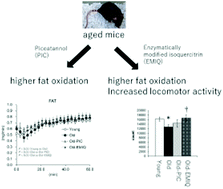Effect of antioxidant supplementation on skeletal muscle and metabolic profile in aging mice†
Abstract
Aging induces drastic changes in muscle mass and function (sarcopenia); however, the detailed mechanisms underlying sarcopenia remain poorly understood. Recent studies suggested that age-related increases in oxidative stress induce muscle atrophy. In this study, we investigated the effect of 6-month supplementation of antioxidants, specifically piceatannol (PIC) and enzymatically modified isoquercitrin (EMIQ), on age-related physiological changes, including skeletal muscle weight and quality, in 25-month-old (OLD) mice, compared to in 4-month-old (young, YNG) C57BL/6J mice. Muscle weight corrected by body weight significantly declined in OLD mice, compared to in YNG mice. The control OLD mice also showed changes in the expression of genes related to muscle fiber type, reduced locomotor activity, and increased oxidative stress markers in blood. Consistent with the muscle weight and quality changes, whole-body fat oxidation during sedentary conditions and exercise periods in control OLD mice was significantly lower than that in YNG mice. Interestingly, compared to the control OLD mice, the PIC- or EMIQ-fed OLD mice showed higher fat oxidation. Furthermore, EMIQ, but not PIC, increased locomotor activity, the expression of genes encoding antioxidant enzymes, and suppressed the carbonylated protein in the skeletal muscle of OLD mice. These results suggested that chronic antioxidant intake could alleviate aging-related muscle function changes.



 Please wait while we load your content...
Please wait while we load your content...